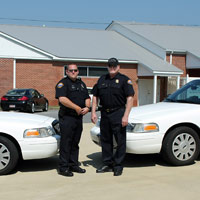 Just a friendly reminder from your Police Department to drive safely and be courteous to others on the road.
Just a friendly reminder from your Police Department to drive safely and be courteous to others on the road.
Don’t become a victim of one of the 6.3 million car crashes that occur each year. Here are five critical mistakes good drivers make and what you can do to avoid them.
Mistake No. 1: Overconfidence
Why it matters: Think you’re a good driver? So do 99 percent of people on the road, according to a National Safety Council survey. Never mind that 93 percent fail to follow basic safety practices like turning off cell phones or obeying the speed limit.
Driving safety instructor Bob Green calls the phenomenon delusions of adequacy or “D.O.A.”
What to do instead: Acknowledge your vulnerability. And even with advanced vehicle safety features, don’t take it for granted that your car is going to protect you.
Mistake No. 2: Multi-tasking
Why it matters: A 2004 study by the Virginia Tech Transportation Institute shows that driver distraction preceded almost 80 percent of crashes.
At 60 mph, you can cover a lot of ground fast — 30 yards per second or the length of a football field in the time it takes to unwrap a hamburger. If you veer off course, you’d better hope there isn’t a bicycle, pedestrian or vehicle in your way.
Driving under the influence of anything, including everyday distractions, is every bit as debilitating as drinking and driving, experts agree. That includes talking on a cell phone, hands-free or not.
Drivers using cell phones are four times more likely to get into a crash, according to the Insurance Institute for Highway Safety. And a handsfree phone doesn’t reduce the risk.
What to do instead: Think of yourself as an airplane pilot — check controls and settings before you take off.
“Train your eyes to look 12 seconds out so you can concentrate on what’s ahead,” says Green. “And remember: smart drivers just drive.”
Mistake No. 3: Failing to Secure Loose Objects
Why it matters: Loose items, from pets to pop cans, cause 13,000 injuries in accidents every year, according to the National Safety Council.
Remember high school physics? In a crash, your car comes to a sudden stop, but anything not battened down keeps moving at the same speed. At 30 mph even the smallest object becomes a dangerous projectile. Think of your 4.4-ounce cell phone as a deadly missile aiming for your toddler with a force of 11 pounds, or two bricks. Or imagine your 60-pound black lab hurling against the back seat with the might of 1,200 pounds.
What to do instead: Put your junk in the trunk. Luggage, laptops and other heavy objects are best stowed in a closed compartment or under a cargo net.
Never place objects on or near the airbag module; even a tissue box is nothing to sniff at when an airbag deploys. Keep pets secured in a latched cargo crate or with a doggy seatbelt.
Mistake No. 4: Drowsy Driving
Why it matters: More than half of American motorists admit to driving while drowsy and one in five say they actually nodded off or fell asleep at the wheel during the past 12 months, according to a report in the New England Journal of Medicine.
“Fatigue is an impairment,” says Green. “You can’t play a good basketball game or a violin solo if you’re whooped. So why would you think you could drive?”
What to do instead: Pay attention to your body. Constant yawning, a nod of the head, heavy eyelids, blurred vision and lane drifting are warnings you may be on the verge of falling asleep.
If you’re tired, stop driving. Rolling down the window, drinking coffee and cranking up the stereo are only temporary fixes. You’ll feel more refreshed if you take a 20-minute power nap. On long trips, stop to stretch every 100 miles or two hours. Drive with someone else in the car whenever possible.
Mistake No. 5: Thinking Green Means Go
Why it matters: One in three Americans admitted to driving through a red light or stop sign without coming to a complete stop in a 2005 poll commissioned by Volvo Cars of North America in partnership with the National Association of Police Organizations and the National Sheriffs’ Association.
That means that even if you’ve got the green, you could be right, but you could be dead wrong.
What to do instead: Yield anyway, even if you have the right of way. Look both ways and then look both ways again. Know what it takes to bring your vehicle to a complete stop.
Don’t trust anyone, insists Bob Schaller, adviser to RoadtripAmerica.com and author of 70 Rules of Defensive Driving. “People trust the other driver to be predictable and do the right thing. They often do not, and we often do not. The result is the 138 people who die each day in traffic crashes on our streets and highways.”

